Intel Core i9-10850K Review: The Real Intel Flagship
by Dr. Ian Cutress on January 4, 2021 9:00 AM EST- Posted in
- CPUs
- Intel
- Core
- Z490
- 10th Gen Core
- Comet Lake
- LGA1200
- i9-10850K
Gaming Tests: Far Cry 5
The fifth title in Ubisoft's Far Cry series lands us right into the unwelcoming arms of an armed militant cult in Montana, one of the many middles-of-nowhere in the United States. With a charismatic and enigmatic adversary, gorgeous landscapes of the northwestern American flavor, and lots of violence, it is classic Far Cry fare. Graphically intensive in an open-world environment, the game mixes in action and exploration with a lot of configurability.
Unfortunately, the game doesn’t like us changing the resolution in the results file when using certain monitors, resorting to 1080p but keeping the quality settings. But resolution scaling does work, so we decided to fix the resolution at 1080p and use a variety of different scaling factors to give the following:
- 720p Low, 1440p Low, 4K Low, 1440p Max.
Far Cry 5 outputs a results file here, but that the file is a HTML file, which showcases a graph of the FPS detected. At no point in the HTML file does it contain the frame times for each frame, but it does show the frames per second, as a value once per second in the graph. The graph in HTML form is a series of (x,y) co-ordinates scaled to the min/max of the graph, rather than the raw (second, FPS) data, and so using regex I carefully tease out the values of the graph, convert them into a (second, FPS) format, and take our values of averages and percentiles that way.
If anyone from Ubisoft wants to chat about building a benchmark platform that would not only help me but also every other member of the tech press build our benchmark testing platform to help our readers decide what is the best hardware to use on your games, please reach out to ian@anandtech.com. Some of the suggestions I want to give you will take less than half a day and it’s easily free advertising to use the benchmark over the next couple of years (or more).
As with the other gaming tests, we run each resolution/setting combination for a minimum of 10 minutes and take the relevant frame data for averages and percentiles.
| AnandTech | Low Resolution Low Quality |
Medium Resolution Low Quality |
High Resolution Low Quality |
Medium Resolution Max Quality |
| Average FPS | 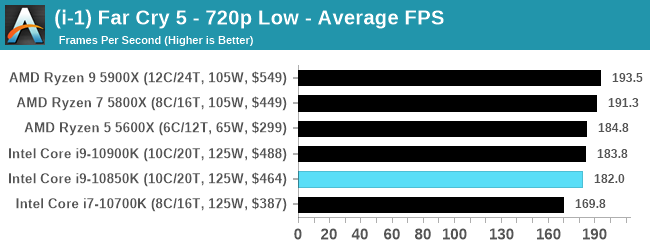 |
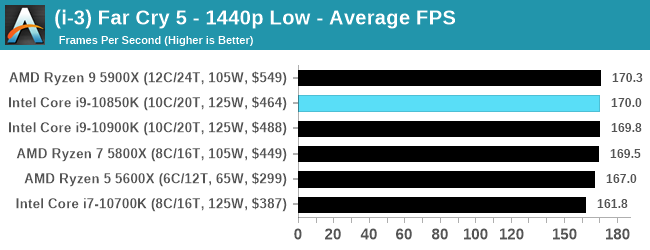 |
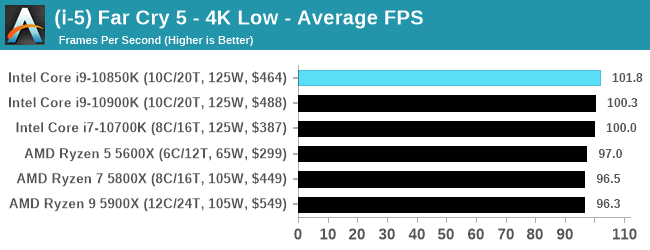 |
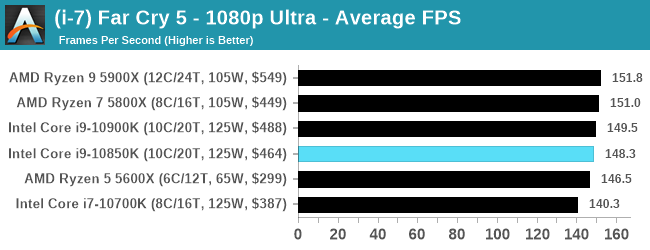 |
| 95th Percentile | 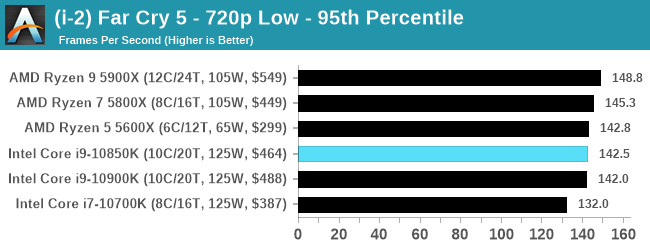 |
 |
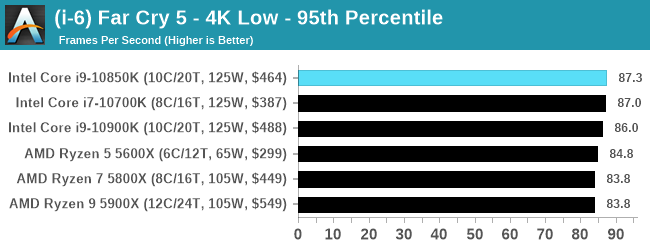 |
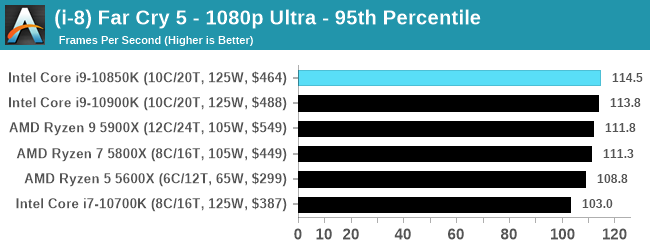 |
All of our benchmark results can also be found in our benchmark engine, Bench.












126 Comments
View All Comments
simpleinhibition - Monday, January 4, 2021 - link
This review is only 6 months after launch. I remember a time when anandtech spent more time doing launch day articles and less time tweetingmrvco - Monday, January 4, 2021 - link
Very diplomatic review, but Intel has become the Dodge of CPUs.Everett F Sargent - Monday, January 4, 2021 - link
"For v2.1, we also have a fully optimized AVX2/AVX512 version, which uses intrinsics to get the best performance out of the software."Hmm, err, none of the CPU's in this review support any of the AVX-512 instruction set afaik.
Pointless to compile explicit AVX-512 instructions or use the AVX-512 compiler flag. We know this because compiling something on an AVX-512 aware CPU will work on an AVX-512 machine but will surely crash on a non-AVX-512 CPU. So the best you can say in this review is that AVX2 was enabled as all of the tested CPU's support AVX2.
Now when Rocket Lake comes out then you have an AVE-512 aware CPU. I really don't care what you all do. But if you are going to use/build custom code then use it in a pure AVE-512 compiled code. Four word versus eight word vectors (assuming 64-bit FP code). That then isolates the AVX-512 advantage which should be ~2X faster (eight/four) afaik.
Everett F Sargent - Monday, January 4, 2021 - link
Oh and the CPU speeds would have the same for all tests. Otherwise you will have to factor in those different CPU clocks. Yes to the slower clocks for AVX2/AVX-512 instructions as per the MHz offsets versus non-vectored code.TeXWiller - Monday, January 4, 2021 - link
Sorry to nit-pick, Ian, but the original definition of the dark silicon was the area of the chip for which there is not enough power or thermal budget to power at the same time as the rest of the chip, instead that of structures that are purposefully added to improve thermal management. The paragraph makes the distinction unclear in my opinion.anarfox - Monday, January 4, 2021 - link
I bit of an overreaction in the comments here. I have one of these with a noctua nh-d15 and it has no problem keeping it cool. And it's not like it have to ramp up the fans either. Is really quiet.An amd cpu might be a better choice of you can get one. But that's not an easy task.
Oxford Guy - Monday, January 4, 2021 - link
‘While these comments make sense, ultimately very few users apply memory profiles (either XMP or other) as they require interaction with the BIOS, and most users will fall back on JEDEC supported speeds’Hogwash.
Ultimately, very few non-enthusiasts read Anandtech. So, citing the people who are not your audience is plain fallacious.
Secondly, no one needs to go to JDEC to gain stability, nor wants to, unless they’re in ECC land. If they didn’t bother to read their motherboard vendor’s supposed RAM list that shouldn’t be a ball and chain around our necks.
Want JDEC? Fine. Do two rounds of tests. Otherwise, stick with the actual sweet spot in terms of price and performance. That is never JDEC.
Oxford Guy - Monday, January 4, 2021 - link
JEDEC, rather. Not even spelling the acronym is par for the course given how irrelevant it is for enthusiasts.As for ‘supposed’, that’s auto-defect.
Dug - Monday, January 4, 2021 - link
"‘While these comments make sense, ultimately very few users apply memory profiles (either XMP or other) as they require interaction with the BIOS, and most users will fall back on JEDEC supported speeds’"Ummmm..... no.
I guess you guys haven't bought a computer in a long time from a vendor. Or even realize that people that do make their own, do apply it because every single guide on youtube, every tech site, every how to blog, shows it. So your assumption is just that, and not realistic.
Dug - Monday, January 4, 2021 - link
And that wasn't directed to anarfox, but Anandtech. No edit in 2021!